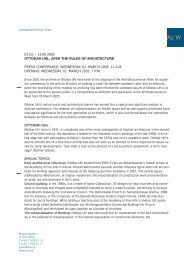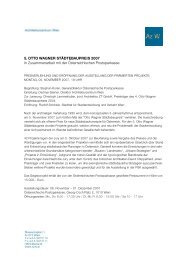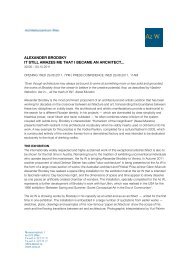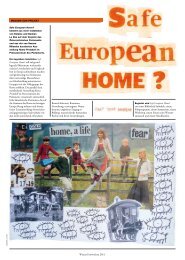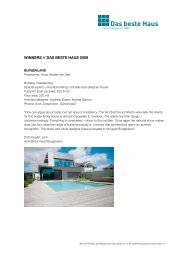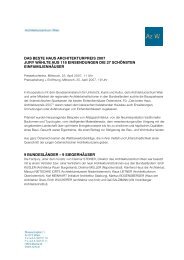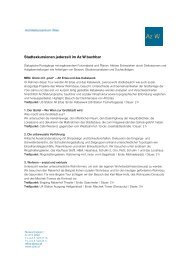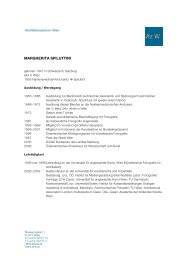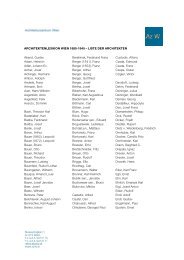Exhibition Hands-On Urbanism 1850 - Architekturzentrum Wien
Exhibition Hands-On Urbanism 1850 - Architekturzentrum Wien
Exhibition Hands-On Urbanism 1850 - Architekturzentrum Wien
You also want an ePaper? Increase the reach of your titles
YUMPU automatically turns print PDFs into web optimized ePapers that Google loves.
HANDS-ON URBANISM <strong>1850</strong> – 2012. THE RIGHT TO GREEN<br />
15.03. – 25.06.2012<br />
OPENING: WED, 14.03.2012, 7 PM | PRESS CONFERENCE: WED, 14.03.2012, 11 AM<br />
“The right to the city is like a shout and a demand“, wrote French intellectual Henri Lefebvre in the 1960s.<br />
Ever since the modernisation shock caused by industrialization, cities have been confronted with<br />
profoundly difficult challenges. It is not only contemporary crises that place conurbations throughout the<br />
world under pressure and reveal approaches to a different kind of urban development from below, in<br />
historical terms, too, one can talk of crisis urbanism that leads to appropriation of land in the city, to selforganisation,<br />
and to informal urban development. In situations of shortage urban dwellers have always<br />
produced solutions. Settlements and vegetable gardens lead to different forms of social cohesion,<br />
neighbourliness and fair distribution. A different world can be planted, as communal gardeners today<br />
emphasise.<br />
The spring exhibition in the <strong>Architekturzentrum</strong> <strong>Wien</strong> is devoted to a history of ideas of appropriating land in<br />
urban space and reveals potential for initiatives by citizens willing to take action in crisis situations. “<strong>Hands</strong>-<br />
<strong>On</strong> <strong>Urbanism</strong> <strong>1850</strong> – 2012” shows a critical history of ideas about the politics of space. Urban<br />
development from below leads to an informal and self-organised production of city, which, however never<br />
operates outside the system. Self-organisation has always been both a reaction to and an incentive for<br />
urban planning. Curator Elke Krasny introduces a different history of the city that raises pressing questions<br />
about the responsibility of architects and planners and about how we use resources.<br />
What can be learned from this urban history from below and how do architects operate within these<br />
processes? Their role ranges from that of initiators to activists and researchers. How does urban planning<br />
react to developments of this kind? The spectrum extends from passive acceptance to the belated<br />
introduction of infrastructure measures and to supportive measures undertaken by the authorities or the<br />
introduction of new laws and legalisation.<br />
Curator: Elke Krasny<br />
Scenography: Alexandra Maringer<br />
<strong>Exhibition</strong> graphic design: Alexander Schuh
ABOUT THE EXHIBITION<br />
Based on many years of field research curator Elke Krasny shows a history of the city from the perspective<br />
of land appropriation and urban development from below. In the course of her international research work<br />
she conducted interviews with architects, planners, activists, researchers, settlers, allotment and<br />
community gardeners. In conceptual terms the exhibition is understood as a specific site of knowledge<br />
production about the history of hands-on urbanism.<br />
“<strong>Hands</strong>-<strong>On</strong> <strong>Urbanism</strong> <strong>1850</strong> – 2012” offers an insight into self-organised, collective, informal urban<br />
movements in the form of projects initiated by self-help, but also by architects and activists and it shows<br />
the new spaces created as a result. Using examples in Europe, Latin America, the USA and Asia it is<br />
shown how often small projects can lead to major changes. Each project is analysed in the context of its<br />
specific historical circumstances. The connection of historical lines and figures of thought to current<br />
developments reflects the important movements that produce a history of the ideas that inspire this<br />
formation of garden space: informality, freedom, neighbourliness, responsibility, bottom up, top down,<br />
rules, boundaries, transgressions, illegality, participation, urban farming, eco-aesthetics …<br />
Scenographer Alexandra Maringer gives spatial form to the curator’s presentation of the history of urban<br />
development from below by developing an urban system as the basic structure of the exhibition.<br />
Construction site mesh fences as support elements directly refer to the qualities of transformation, the<br />
changing of the city, to the act of building, which in the case of urban development from below is often selfbuild.<br />
Contemporary and historical photographs, films, plans and sketches fixed to the mesh tell about the<br />
effects of hand-on urbanism.<br />
The mesh fencing also provides a support for the main aspect of the exhibition: the right to green. Different<br />
kinds of useful, ornamental and wild plants are fixed to it. City and country, gardening in the city as a<br />
practical means of survival, of subsistence, of creating community and as an expression of delight in<br />
planting are directly transplanted to the exhibition space and evoked by the scent and texture of the plants.<br />
And, not least importantly, as is often the case in urban development from below recycling and intelligent<br />
use of resources play an important role: re-use and adaptation of found materials (mesh, bottles ...), urban<br />
resources (MA42, MA48), and seating cubes made of waste timber. And, potted in transparent containers,<br />
visitors see two further resources employed by urban farming and community gardens: earth and water.<br />
The narrative of the individual case studies in this history of urban development from below is integrated in<br />
this urban structure. Visitors to the exhibition stroll through the stations of the case studies in a time frame<br />
spanning from <strong>1850</strong> to 2012. Views through the mesh provide a spatial translation of the varied and<br />
complex cross-references.
CASE STUDIES HANDS-ON URBANISM <strong>1850</strong> – 2012<br />
The range of case studies examined by Elke Krasny during several years of field research extends from<br />
“Schreberplatz”, created in mid-19th century Leipzig, to current developments in Paris, London, Berlin,<br />
Hong Kong, Porto Alegre and Quito. The Viennese Settlers’ Movement, its cooperative legacy and the<br />
historic allotment garden movement, as well as allotment gardens and the informal garden culture of<br />
refugees and asylum seekers in Vienna today also play a role in this “other” history of the city.<br />
- “Schreberplatz”, Leipzig. A self-organised association grouped around educationalist Ernst<br />
Hauschild founded the first Schreberverein in 1865 and subsequently initiated a self-governing<br />
garden.<br />
- Hull House, Chicago, from 1889. Jane Addams, feminist and later recipient of the Nobel Peace<br />
Prize initiated the Hull House Settlement in a poor district of Chicago with a high immigrant<br />
population.<br />
- Allotment gardens, „The Future on the Schmelz“, Vienna. During World War I the first vegetable<br />
gardens were laid out informally on this site that today is Central Europe’s largest allotment garden<br />
complex.<br />
- Settler movement Vienna. From 1918 onwards informal, so-called “wild”, settlers and gardeners<br />
organised themselves in cooperative associations.<br />
- Living on lots, Bremen, from 1945. After World War II this self-organised, informal settlement and<br />
subsistence farming developed on allotment garden lots.<br />
- Ma Shi Po Village, Hong Kong, from 1947. After World War II informal squatter cottages were<br />
erected in self-build. Today Becky Au, initiator of the Ma Po Po Community Farm, is attempting to<br />
save the fields from pressure being exerted by developers.<br />
- The Cook, the Farmer, his Wife and their Neighbor, Amsterdam. In the urban district Nieuw West<br />
that was planned after World War II as a rationalised garden city, the group Wilde Westen<br />
(architects, designers, culture producers) and the artist Marjetica Potrč carried out a communal<br />
garden from 2008-2009.<br />
- Macondo, Vienna. Refugees from different countries arrived here from 1956 onwards. An informal<br />
garden culture developed. When its continued existence was threatened, the artists group Cabula6<br />
began working here in 2009 and made a recycle garden.<br />
- Sarigöl, a Gecekondu, Istanbul. Informal urban expansion began in Istanbul After World War II.<br />
Today Gecekondus are threatened by pressure from developers.<br />
- Bowery-Houston Community Farm and Garden, New York. Liz Christy, local resident and artist,<br />
initiated this garden in 1973. Under Mayor Giuliani many of the Loisaida gardens were destroyed.<br />
- Mexicali Experimental Project, Mexico. In a participatory process Christopher Alexander realised<br />
this settlement from 1975 onwards. In the 1990s, Ana Laura Ruesjas explored the informal<br />
changes to the Mexicali Project undertaken by its residents.
- La Quebrada Navarro, Quito. Andinos erect informal settlements and farm in the raines of Quito.<br />
Since 2010 Pablo Molestina and Catherine Venart have been working on plans to preserve the<br />
complex ecological system and its use.<br />
- Organopónicos Havana. Urban farming, which started informally after the break-up of the USSR<br />
and was then introduced throughout Cuba, was examined by Bohn and Viljoen Architects as an<br />
exemplary continuous productive urban landscape.<br />
- Centro de Educação Ambiental da Vila Pinto, educational centre and recycling complex, Porto<br />
Alegre. In this favela Doña Marli Medeiros initiated a cooperative recycling complex in 1994. In<br />
2010 she asked architect Felipe Hernández to work on a joint design for the outdoor space.<br />
- What will the Harvest be? London. A group of residents known as the Friends of Abbey Gardens,<br />
and the artists group Somewhere (Karen Guthrie & Nina Pope) have been running this public<br />
neighbourhood garden with an “honesty stall” since 2006 in the face of developer and gentrification<br />
pressure caused by the planned London Olympics in 2012.<br />
- Prinzessinnengarten, Berlin. <strong>On</strong> an area of urban wasteland in Kreuzberg left unused for decades<br />
Robert Shaw and Marco Clausen have been operating this mobile urban farm with garden café<br />
since 2009 as a neighbourhood hub but also for tourists.<br />
- More than Shelters. <strong>On</strong> the basis of the self-help ideology of John Turner, artist Daniel Kerber has<br />
been working since 2010 on a concept for mobile modular emergency shelters for acute crisis<br />
situations and homelessness.<br />
- R-Urban, Colombes / Grand Paris. Since 2011 aaa atelier d’architecture autogerée (Constantin<br />
Petcou and Doina Petrescu) have been working on a pilot project that is based on closed local<br />
circuits and combines urban farming, a recycling plant, and a cooperative housing project with the<br />
right to the city and to future resilience.<br />
In conjunction with the exhibition a book is published in German with Turia + Kant Verlag, Vienna and in<br />
English with MCCM Creations, Hong Kong.
Thanks to:<br />
Caterina Hildebrand (Leipzig), Una Steiner (Schmelz, Vienna), Andrea Seidling (Settlers’ Movement, Vienna),<br />
Kirsten Tiedemann und Angie Oettingshausen (Bremen), Chi-Ho Chung und Shu-Mei Huang (Hong Kong),<br />
Cabula6 and Arquitectos (Macondo, Vienna), Ingrid Sabatier & Stephan Schwarz, ISSSresearch (Istanbul),<br />
Ana Laura Ruesjas (Mexikali), Lucia Babina und Marjetica Potrč (Amsterdam), Marco Clausen (Berlin), Pablo<br />
Molestina und Catherine Venart (Quito), Katrin Bohn (Havanna), Andreas Lang (London), Daniel Kerber<br />
(morethanshelters), Felipe Hernández, Rosana Bauer, Fernando Freitas Fuño and Apurba K. Podder (Porto<br />
Alegre), Doina Petrescu and Constantin Petcou (Paris), Alexandra Maringer (Paris)<br />
Az W is funded by: Urban Planning, Traffic & Transport, Climate Protection, Energy and Public<br />
Participation, Vienna / Austrian Federal Ministry for Education, Arts and Culture<br />
Az W is supported by: Architecture Lounge<br />
The press release and high resolution photos are available for download at<br />
www.azw.at/press_therighttogreen.<br />
Press contact, Az W<br />
Irene Jäger<br />
T +43 1 522 31 15-23<br />
jaeger@azw.at



